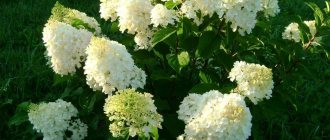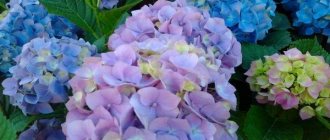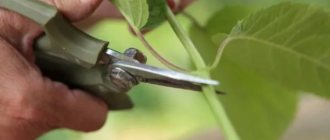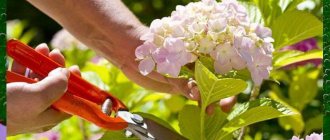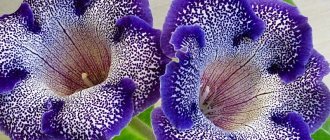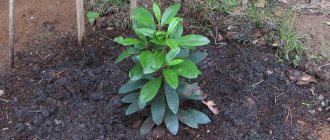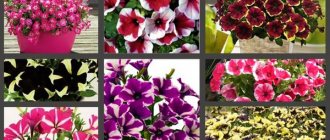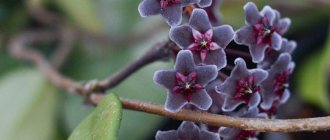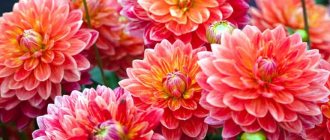Choosing a healthy seedling
All beautiful hydrangea bushes start with a small seedling. How well the plant will take root in a new place and will delight you with large inflorescences depends on its condition. Therefore, we immediately remember the basic rules for choosing a seedling:
- You need to buy from nurseries and online garden stores.
- You need to choose seedlings with a closed root system. The pot will allow you to keep the hydrangea until the frosts have completely subsided.
- To check the root system, the plant is carefully pulled out of the container along with a lump of earth. The roots should be healthy, moist, without dry shoots, signs of rot or mold.
- The optimal size is 2-4 even, strong shoots.
- For greater guarantee, you can wait until the end of May or the beginning of July and buy a plant that is already vegetating.
- The health of hydrangea is indicated by symmetrical elastic leaves of a rich green color.
How to plant hydrangeas correctly: 7 main features
Hydrangea is a flowering shrub absolutely stunning in its marvelous beauty. The huge, colorful, lush caps of its inflorescences captivate the eye and make you forget about everything in the world.
The gradual change in colors and shades of its flowers is also striking. It’s as if you find yourself at some fabulous ball of flowers changing their clothes from pale green to snow-white crimson, and soft blue to lilac-violet or snow-white-gold.
The richness of shades in the multi-colored inflorescences of hydrangeas is so great that you seem to dissolve in it and never want to leave this marvelous corner of the blooming garden.
We have already talked about the nature of the appearance of this wonderful crop, about its types and in great detail about agricultural technology in published articles:
“Choosing frost-resistant hydrangeas”;
“How to care for hydrangeas in summer and autumn.”
Today we will talk about how to plant hydrangeas correctly. There are many subtleties here, without knowledge of which you may not get a beautiful shrub with lush tassels-inflorescences. It may not take root at all and die in the first winter if planting is done incorrectly and not at the right time.
MAIN FEATURES OF PLANTING HYDRENSA
Bushes should be planted, replanted and divided only in the spring.
Many gardeners believe that hydrangeas, like most perennial ornamental plants, need to be planted and replanted in late August - early September.
But this is a big mistake. Hydrangea is slow and difficult to take root in a new place, so it needs enough time for this. As a rule, in most of Russia, hydrangeas are planted in mid-May (in more northern regions - at the end of the month). In the south of the country, autumn planting is also acceptable.
Over the summer, the young bushes will take root well in the new place and have time to prepare for the winter cold.
It is very important to choose the right place to plant hydrangeas..
Hydrangea should be planted in light partial shade, so that during the midday hours (from 12 to 15 o'clock) it is not exposed to the scorching rays of the sun. The rest of the time it should be brightly lit, otherwise you will not get beautiful flowering.
Planted in the shade, the hydrangea will begin to hurt, its inflorescences will become smaller, and eventually the plant may simply die.
Another area chosen for planting hydrangeas should be well protected from cold winds and drafts. A beautiful sissy, hydrangea will suffer greatly even from a not very strong draft. This again could lead to her illness.
It is best to choose a place for her near the south side of the house, protected by its wall, fence or other bushes. But at the same time, the latter should not shade it from the sun.
Hydrangeas do not tolerate close groundwater (they should be no closer than 1.5 m from the surface of the earth). And they will not grow in flooded low-lying areas. Water should not stand around the bushes.
In such conditions, hydrangeas are planted in high flower beds at least 50 cm high.
Soil plays a huge role in the proper growth and development of hydrangeas..
Hydrangeas love fertile, loose, well-watered and breathable neutral or slightly acidic soils (pH 6.5 - 7.0), rich in organic matter. On heavy clays with an acidic reaction, it is necessary to carry out neutralization. For this, dolomite flour is used (2 kg per 5 sq. m of planting area).
It is advisable to perform this operation in the fall, but it can also be done in the spring at least 3 weeks before planting.
Hydrangeas also don't like alkaline soils, so don't plant them near an outdoor sink or where you pour water after washing.
You need to know how to plant hydrangea correctly.
When planting, all native soil from the planting holes is selected and filled with a soil mixture, which we recommend that you make up of: top fertile layer, rotted manure, leaf soil and sand (preferably river sand) in equal quantities.
Additionally, add the following fertilizers to each hole: superphosphate (2 tablespoons), potassium sulfate (1.5 tablespoons), wood ash (1/4 bucket) and dolomite flour (1 cup only on acidic soils).
Planting holes are dug with a depth and a diameter of 40 cm. At the bottom of each hole, drainage from broken brick or crushed stone is laid in a layer of 10 cm. After planting, the root collar of the hydrangea should be at ground level.
Water the planted bushes well (2 watering cans for each) and mulch with peat chips or sawdust. This operation will help retain moisture in the soil and prevent the growth of weeds in the tree trunks of young plants.
Neighboring plants are very important for hydrangea.
Hydrangeas are greatly influenced by the plants planted next to them. Under no circumstances should it be planted next to black currants, since the essential oil substances found in the tissues of this berry crop negatively affect the delicate hydrangea.
Also an undesirable neighbor will be white acacia, the roots of which emit toxic substances that inhibit the root system of hydrangea.
Perennial flowers will be wonderful neighbors - peonies, irises, hosts, astilbes, hybrid tea roses.
Do not place a bed of hydrangeas next to herbs and garlic. If you are planning a flower garden next to a vegetable garden, the best neighbors for hydrangea will be cucumbers and zucchini.
Do not plant hydrangeas near trees or tall shrubs with developed root systems, even if they do not shade them. These “neighbors” will constantly take away all the nutrients and water from the more tender and delicate hydrangea!
Planting hydrangeas will not be successful without abundant watering.
Remember an important rule: hydrangeas are watered only with warm water, heated to a temperature of at least 30 degrees!
In the first two weeks after planting, hydrangeas are watered every day (if the weather is dry and sunny and the air temperature is above +16 degrees). If the air warms up only to +14 degrees, water once every 3 days. In such conditions, the plant stops growing and seems to freeze, waiting for warmer weather!
Then reduce watering to twice a week. After a month, one weekly watering will be enough (in the hot weather, increase the frequency of watering).
How to influence the color of hydrangea flowers when planting.
The color of hydrangea is one of the main varietal characteristics, so it is inherent in it from the very beginning (each variety has its own). But if you want to experiment a little, you can give the flowers either blue or pink.
When planting, acidify the soil with a weak solution of citric acid or Blue Hydrangea fertilizer, and you will get various blue shades of flowers.
If you want them to be pink, add crushed chalk or 1.5 cups of dolomite flour. And if you want to get both shades on different inflorescences at the same time, add the above ingredients from different sides of the bush.
But it is better to do this not at planting, but after a couple of years, when the bush has grown and become stronger.
THE BEST VARIETIES OF HYDRANGEAS FROM OUR COLLECTION
Now that you know how to properly plant hydrangeas in the spring, we offer you the best varieties from our unique collection of this most beautiful, bright and luxuriantly flowering shrub, which will delight you with its truly unearthly beauty for many years.
Our new products:
Hydrangea oakleaf: Harmony, Snow flakes.
Our collection:
Hydrangea bigleaf: Joy, Fire Red, Bluebird, Mint.
Hydrangea tree: Sterilis, Annabelle .
Hydrangea paniculata: Grandiflora, Vanilla Fries, Sunday Fries, Unique, Lemon Light .
You can buy all these varieties from us today!
Ideal place for hydrangea
Hydrangeas are not the most capricious flower, but their location is key. Here you will have to come to terms with it and plant it not where you want, but where it will be best for the plant.
- For paniculate varieties, you need to choose a place with partial shade. In strong sun it shrinks and degenerates, but without light it also feels bad.
- It’s the same with tree hydrangea - the plant loves moderate sunlight without scorching direct rays. Ideally, bushes should be planted near shrubs and trees that will provide them with the necessary protection.
- Petiolate (creeping) species tolerate shade best. They grow well near walls and high fences. Good soil permeability is important for hydrangea.
Planting hole size
For active growth and flowering, hydrangea requires nutritious soil. To grow it in areas with poor soil, it is necessary to thoroughly fertilize the planting hole. For a young seedling, prepare a depression measuring 30x30 cm and 40-50 cm deep.
For mature plants, a wider hole will be required. The pit is enlarged if the soil has to be conditioned by adding sand, humus or a nutrient mixture. A distance of 1.5-2.5 meters is maintained between adjacent holes so that adult plants do not interfere with each other.
How to care for a plant in open ground?
For beautiful, lush flowering of hydrangea, proper care is necessary.
Trimming
Hydrangea is one of the garden shrubs that can grow up to 30 cm in height in one season, and therefore this plant needs regular and preventive pruning.
The first is done on plants that have reached 3-4 years of age in early spring before sap flow and buds begin to bloom. You should prune during the period when the buds are swelling.
Important! Too early a procedure will result in unsuitable cuttings for further rooting. If pruning is delayed, the bush may die
. The plant is trimmed with pruning shears, cutting off ¾ of each shoot, leaving 2–3 pairs of buds. It is recommended to renew old bushes, so they are cut off almost to the root.
You can clearly see the procedure for pruning hydrangeas in this video:
Fertilizer
Like any garden plant, hydrangea needs complex fertilizing , which strengthens the branches of the plant, and makes the inflorescences themselves more lush and bright. Fertilizers are applied twice a year:
- In the spring, during the period of bud formation, 20 grams of urea per bucket of water (for an adult plant you will need 3 buckets of solution).
- After flowering, hydrangea is fed with complex mineral fertilizers, which necessarily include: nitrogen, potassium and phosphorus.
Reference! Over time, the acidity of the soil decreases, so it is periodically acidified.
You can learn more about fertilizers for hydrangea from this video:
After flowering
As soon as the hydrangea stops flowering, preparations for winter begin. The first thing to do is remove the flower stalks so that suddenly falling wet snow does not stick to them and break the fragile branches of the plant. There is no need to try to remove them to the very root, just cut them down to the middle. They also perform autumn preventative pruning: get rid of dry, diseased or broken branches.
Caring for shrubs in summer
Summer maintenance of hydrangea involves a set of agrotechnical measures that contribute to the favorable progress of all stages of its growing season:
- Regular watering (once a week - 2-3 buckets of rain or settled water, more often in hot weather).
- Removing weeds and shoots from the root circle, loosening to a depth of 10 cm and mulching up to 3 times per season.
- Adding well-rotted organic matter. The main thing is not to overdo it, otherwise the plants will start to grow uncontrollably. Some gardeners prefer granular organic fertilizers sold in specialty stores.
- A regulating and formative type of pruning to obtain a truly beautiful, flowering and lush bush.
Proper fertilizer when planting
Suitable soil is rare, but it can be adapted so that the hydrangea takes root and begins to grow immediately. For drainage, sand or broken bricks are poured into the bottom of the hole.
The remaining volume is filled with a substrate of excavated soil, humus and high-moor peat. This composition will allow you to grow hydrangea even in a clayey place with poor soil. Recommended proportions: 2 parts each of turf soil and humus and 1 part each of clean sand and peat.
Before planting the seedling, the earthen ball should be lightly shaken off so that the roots straighten and grow faster. The plant goes deep into the prepared nutrient “cocktail” to the level of the root collar.
General description of hydrangea paniculata
Paniculata hydrangea (Hydrangea Paniculata) in captivity is a shrub 1.5–3 m high with a rounded rather dense crown. The leaves are oval, 10–12 cm long. It grows quite actively, adding 25–30 cm per season, and begins to bloom in the year of planting or the next season. But it is recommended to remove the first buds to allow the bush to get stronger. The lifespan of the plant is 50–60 years.
The easiest way to use paniculata hydrangea in landscape design is as a tapeworm.
Flowers are collected in inflorescences of different densities and pyramidal shapes. The length of the inflorescence can reach 20–25 cm. They consist of two types of flowers - large and bright sterile and small, almost invisible, producing seeds. Over the course of the summer, most hydrangea flowers gradually change color. Mainly white, cream, greenish, pink, and red tones are combined. The flowers emit a delicate, pleasant aroma, which makes the plant an excellent honey plant.
Hydrangea paniculata flowers gradually change color over the course of the season.
Flowering continues from late June until the first frost. In central Russia, they usually occur in October. Cold resistance down to -30°C allows you to cultivate hydrangea even in the Urals and Siberia. Provided it is covered, it will withstand even more severe frosts.
If you cut hydrangea inflorescences at the moment when you like their shade and dry them in a suspended state with the crown down, you can collect very beautiful ikebana, winter bouquets, and other decorative compositions from the resulting dried flowers.
Dried hydrangea flowers can be used in winter to create beautiful bouquets
Frequency and abundance of watering
For their love of moisture, hydrangeas are given the name Hydrangea (water container), so be prepared for frequent watering. Bushes should not be planted in an area where the owners visit only on weekends. For irrigation, you need settled, lukewarm water from the tap or collected rainwater.
When planting, the bush is only sprayed. In the next 2 weeks, the plant is watered once every 2-3 days. Next, simply keep the soil moist, preventing it from drying out. To protect from drying out, the surface around the hydrangea is slightly compacted and mulched with bark, sawdust or pine needles.
Proper pruning of hydrangea: spring and autumn
All species tolerate pruning well and need it, but each has its own characteristics. Pruning in spring can only be done from 3-4 years of age. The most common types of hydrangeas in Russian gardens are divided into two groups according to the type of pruning.
Group No. 1 (large-leaved (garden), prickly, serrated, oak-leaved, Sargent and petiolate hydrangea)
These species bloom on last year's shoots and require sanitary and cosmetic pruning. The optimal time for pruning is as soon as the buds have swollen a little, there is no active movement of juices, plus such pruned shoots can be rooted. Let's use the example of garden hydrangea.
Large-leaved hydrangea (macrophila) cannot be pruned, but can only be rejuvenated. Every spring, prune every fourth branch older than 3 years, especially those growing inward, so that the bush does not thicken, as well as dead, weak (thin) or broken stems at the root. This pruning, in addition to giving a more decorative shape, improves flowering.
Spring pruning of garden hydrangea (large-leaved)
Exception: modern varieties from the “Forever and ever”, “You&Me” series, as well as the “MiniPenny” varieties, which bloom on the shoots of the first and previous years. They are pruned depending on the condition of the plant and the past winter.
- Petiolate hydrangea is lightly pruned: long stems are shortened for better branching.
Group No. 2 (tree-like and paniculate)
These species, which bloom on young shoots (current season), are pruned every year before the buds open. Best time: mid-late March (as soon as the snow has melted). Annual formative pruning is required, since if the flower thickens, the inflorescences will become smaller.
- Hydrangea tree is the first to wake up. The shoots are cut to 2-3 buds from the ground. On a powerful and mature bush, sometimes only one pair of buds is left. To form a decorative shape of the bush, shoots that are weak and growing inward are pruned.
- Hydrangea paniculata needs more gentle pruning. Last year's shoots are shortened by a third.
Adviсe
- To thin out the bush, remove completely every year old, weak and inward-growing shoots.
- Trim frozen stems to the first living bud.
Bush rejuvenation
It is easy to rejuvenate an old bush using special pruning: cut all shoots at a height of 5-7 cm from ground level (“under the stump”) or to the level of perennial wood. Next spring, young shoots will begin to grow, and the decorative appearance of the bush will be restored.
Should I prune my hydrangea for the winter?
In the fall, faded inflorescences of hydrangeas must be cut off so that the branches do not break under the weight of snow.
Standard form
Hydrangea paniculata can be grown as a tree - a low standard. Select one of the most developed shoots on a two-year-old plant grown from an apical cutting, and cut off the rest. Then prune this shoot to the strongest bud every year in the spring until it reaches 100 cm in height.
To form a crown in subsequent years, pinch the top of the shoot, and new shoots are removed completely. In the future, weak shoots are cut off annually and only 4-5 strongest branches are left for bushiness.
An example of the standard form of paniculata hydrangea
Protection from pests and diseases
For 2-3 years after planting, hydrangea bushes do not require pruning, and the substrate rich in nutrients is enough for the full development of the plant. But the flower may suffer from pests.
Wet soil promotes the development of rot and fungal diseases. If a whitish coating, rusty spots or causeless wilting of foliage appears, you need to remove all damaged parts and treat the hydrangea with a fungicide.
Insecticides help against pests. To combat diseases due to improper care, adjustments are made: hard water is replaced, the amount of fertilizer is reduced.
Preparing for winter
Many hydrangea varieties are acclimatized for countries with cold climates. For successful wintering, young plants must be insulated. The roots may not be affected, but the young shoots will die from frost.
In the southern regions, hilling is sufficient, but in the northern regions it is necessary to cover with spruce branches, peat and film. The plant can also be placed in a rigid frame and covered with dry leaves or wrapped in hay or straw.
If you figure it out, taming the whimsical hydrangea is not at all difficult. We have broken down the first year of life from planting in open ground to wintering into simple recommendations that will help you grow a beautiful flowering bush from a small seedling.
